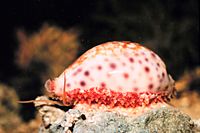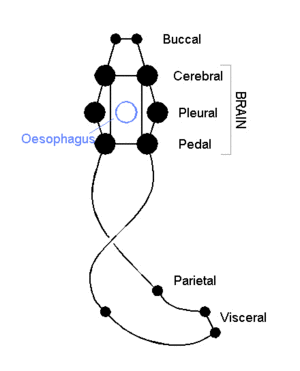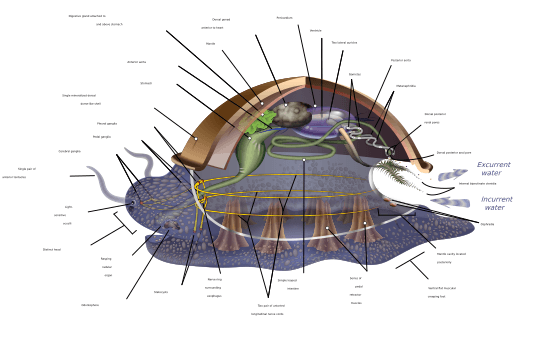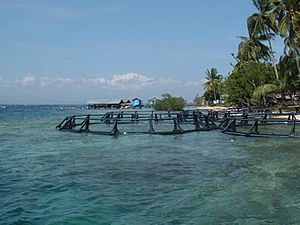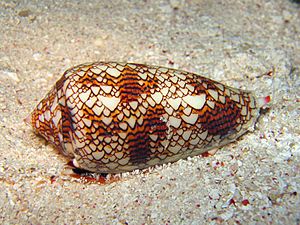Mollusc facts for kids
Quick facts for kids Molluscs |
|
|---|---|
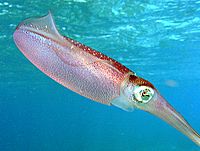 |
|
| Caribbean reef squid, Sepioteuthis sepioidea | |
| Scientific classification | |
| Kingdom: | |
| Phylum: |
Mollusca
Linnaeus, 1758
|
Molluscs (or mollusks) are an important phylum of invertebrate animals. Most of them are marine. They have huge numbers in-shore, that is, in shallow waters near the shore. They are the largest marine phylum, with about 85,000 living species, 23% of all named marine organisms. They also occur in freshwater and on land.
Molluscs are extremely varied: they have great diversity. That may be why there is no word in English for the phylum as a whole. "In an evolutionary sense, molluscs are plastic material". They have much more variety than their ancient rivals, the brachiopods.
Most molluscs have shells, but some groups do not: octopods, slugs, and the gastropods known as sea slugs.
Contents
Diversity
Many molluscs also live in freshwater and terrestrial habitats. They are highly diverse, not just in size and in anatomical structure, but also in behaviour and in habitat.
The phylum is usually divided into 9 or 10 taxonomic classes, of which two are entirely extinct. Cephalopod molluscs, such as squid, cuttlefish and octopus, are among the most neurologically advanced of all invertebrates: they have good brains and complex behaviours. Either the giant squid or the colossal squid is the largest known invertebrate species. The gastropods (snails and slugs) are by far the most numerous molluscs in terms of classified species, and account for 80% of the total. The scientific study of molluscs is called malacology.
Main features
The three most universal features defining modern molluscs are:
- a mantle with a cavity used for breathing and excretion,
- the presence of a radula, and
- the structure of the nervous system.
Other than these things, molluscs have so much variety that many textbooks use a "hypothetical ancestral mollusc" to summarise them (see below). This has a single, "limpet-like" shell on top, which is made of proteins and chitin reinforced with calcium carbonate. It is secreted by a mantle covering the whole upper surface. The underside of the animal consists of a single muscular "foot".
The mollusc's feeding system starts with a rasping "tongue", the radula. The complex digestive system uses mucus and microscopic, muscle-powered "hairs" called cilia. The generalized mollusc has two paired nerve cords, or three in bivalves. The brain, in species that have one, circles the oesophagus. Most molluscs have eyes, and all have sensors to detect chemicals, vibrations, and touch. The simplest type of molluscan reproductive system relies on external fertilization, but more complex variations occur. All produce eggs, from which may emerge trochophore larvae, more complex veliger larvae, or miniature adults.
A striking feature of molluscs is the use of the same organ for multiple functions. For example, the heart and nephridia ("kidneys") are important parts of the reproductive system, as well as the circulatory and excretory systems. In bivalves, the gills both "breathe" and produce a water current in the mantle cavity: this is important for excretion and reproduction. In reproduction, molluscs may change gender to accommodate the other breeding partner.
Good evidence exists for the appearance of gastropods, cephalopods and bivalves in the Cambrian period, 541 to 485.4 million years ago (mya). Before that, the evolutionary history of molluscs' emergence from the ancestral Lophotrochozoa is still unclear.
Mollusc species can also represent hazards or pests for human activities. The bite of the blue-ringed octopus is often fatal, and that of Octopus apollyon causes inflammation that can last for over a month. Stings from a few species of large tropical cone shells can also kill: their venoms have become important tools in neurological research. Schistosomiasis (also known as bilharzia, bilharziosis or snail fever) is transmitted to humans via water snail hosts, and affects about 200 million people. Snails and slugs can also be serious agricultural pests, and accidental or deliberate introduction of some snail species into new environments has seriously damaged some ecosystems.
A "generalized mollusc"
Because of the great range of anatomical diversity among molluscs, many textbooks start the subject of molluscan anatomy by describing what is called an archi-mollusc, hypothetical generalized mollusc, or hypothetical ancestral mollusc (HAM) to illustrate the most common features in the phylum. The picture is rather similar to modern monoplacophorans: some think it may resemble very early molluscs.
The generalized mollusc is bilaterally symmetrical and has a single, "limpet-like" shell on top. The shell is secreted by a mantle covering the upper surface. The underside consists of a single muscular "foot". The visceral mass, or visceropallium, is the soft, nonmuscular metabolic region of the mollusc. It contains the body organs.
Taxonomy
Classes of molluscs:
- Aplacophora: molluscs: the living ones are shell-less
- Bivalvia: Most shellfish; clams, oysters, scallops, mussels
- Cephalopoda: Squid, Octopus
- Gastropoda: whelks, limpets, snails, slugs, Nudibranchs
- Helcionelloida: (see below)
- Monoplacophora: molluscs with a cap-like shell
- Polyplacophora: Chitons
- †Rostroconchia: an extinct group
- Scaphopoda: the tusk shells
Helcionelloida
It has become clear that the fossil taxon Helcionelloida does not belong to the class Gastropoda. It is now a separate class in the Mollusca. Parkhaev (2006, 2007) created the class Helcionelloida, whose members were previously treated as "Paleozoic molluscs of uncertain systematic position" by Bouchet & Rocroi.
Human interaction
For millennia, molluscs have been a source of food for humans, as well as important luxury goods, notably pearls, mother of pearl, Tyrian purple dye, sea silk, and chemical compounds. Their shells have also been used as a form of currency in some preindustrial societies. A number of species of molluscs can bite or sting humans, and some have become agricultural pests.
Uses by humans
Molluscs, especially bivalves such as clams and mussels, have been an important food source since at least the advent of anatomically modern humans, and this has often resulted in overfishing. Other commonly eaten molluscs include octopuses and squids, whelks, oysters, and scallops. In 2005, China accounted for 80% of the global mollusc catch, netting almost 11,000,000 tonnes (11,000,000 long tons; 12,000,000 short tons). Within Europe, France remained the industry leader. Some countries regulate importation and handling of molluscs and other seafood, mainly to minimize the poison risk from toxins that can sometimes accumulate in the animals.
Most molluscs with shells can produce pearls, but only the pearls of bivalves and some gastropods, whose shells are lined with nacre, are valuable. The best natural pearls are produced by marine pearl oysters, Pinctada margaritifera and Pinctada mertensi, which live in the tropical and subtropical waters of the Pacific Ocean. Natural pearls form when a small foreign object gets stuck between the mantle and shell.
The two methods of culturing pearls insert either "seeds" or beads into oysters. The "seed" method uses grains of ground shell from freshwater mussels, and overharvesting for this purpose has endangered several freshwater mussel species in the southeastern United States. The pearl industry is so important in some areas, significant sums of money are spent on monitoring the health of farmed molluscs.
Other luxury and high-status products were made from molluscs. Tyrian purple, made from the ink glands of murex shells, "fetched its weight in silver" in the fourth century BC, according to Theopompus. The discovery of large numbers of Murex shells on Crete suggests the Minoans may have pioneered the extraction of "imperial purple" during the Middle Minoan period in the 20th–18th centuries BC, centuries before the Tyrians. Sea silk is a fine, rare, and valuable fabric produced from the long silky threads (byssus) secreted by several bivalve molluscs, particularly Pinna nobilis, to attach themselves to the sea bed. Procopius, writing on the Persian wars circa 550 CE, "stated that the five hereditary satraps (governors) of Armenia who received their insignia from the Roman Emperor were given chlamys (or cloaks) made from lana pinna. Apparently, only the ruling classes were allowed to wear these chlamys."
Mollusc shells, including those of cowries, were used as a kind of money (shell money) in several preindustrial societies. However, these "currencies" generally differed in important ways from the standardized government-backed and -controlled money familiar to industrial societies. Some shell "currencies" were not used for commercial transactions, but mainly as social status displays at important occasions, such as weddings. When used for commercial transactions, they functioned as commodity money, as a tradable commodity whose value differed from place to place, often as a result of difficulties in transport, and which was vulnerable to incurable inflation if more efficient transport or "goldrush" behavior appeared.
Bioindicators
Bivalve molluscs are used as bioindicators to monitor the health of aquatic environments in both fresh water and the marine environments. Their population status or structure, physiology, behaviour or the level of contamination with elements or compounds can indicate the state of contamination status of the ecosystem. They are particularly useful since they are sessile so that they are representative of the environment where they are sampled or placed. Potamopyrgus antipodarum is used by some water treatment plants to test for estrogen-mimicking pollutants from industrial agriculture.
Harmful to humans
Stings and bites
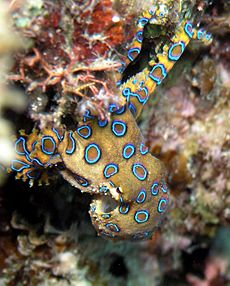
Some molluscs sting or bite, but deaths from mollusc venoms total less than 10% of those from jellyfish stings.
All octopuses are venomous, but only a few species pose a significant threat to humans. Blue-ringed octopuses in the genus Hapalochlaena, which live around Australia and New Guinea, bite humans only if severely provoked, but their venom kills 25% of human victims. Another tropical species, Octopus apollyon, causes severe inflammation that can last for over a month even if treated correctly, and the bite of Octopus rubescens can cause necrosis that lasts longer than one month if untreated, and headaches and weakness persisting for up to a week even if treated.
All species of cone snails are venomous and can sting painfully when handled, although many species are too small to pose much of a risk to humans, and only a few fatalities have been reliably reported. Their venom is a complex mixture of toxins, some fast-acting and others slower but deadlier. The effects of individual cone-shell toxins on victims' nervous systems are so precise as to be useful tools for research in neurology, and the small size of their molecules makes it easy to synthesize them.
Images for kids
-
The use of love darts by the land snail Monachoides vicinus is a form of sexual selection
-
The enigmatic Kimberella quadrata (fossil pictured) from the Ediacaran has been described as being "mollusc-like" because of its features which are shared with modern day molluscs.
-
Skin vesicles created by the penetration of Schistosoma. (Source: CDC)
See also
 In Spanish: Mollusca para niños
In Spanish: Mollusca para niños


